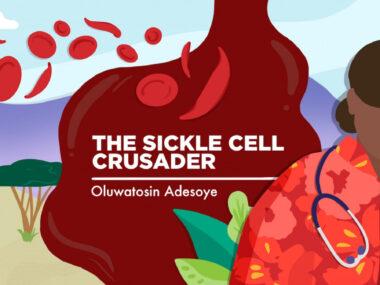Worldwide, sickle cell may be more deadly than thought, analysis finds
Number of children born with SCD also rising in high-prevalence regions
Written by |

The global burden of sickle cell disease (SCD) may be greater than previously thought, with mortality rates up to 11 times higher than earlier estimates, a recent analysis reported.
Particularly vulnerable are people living in sub-Saharan Africa and children younger than age 5.
Failures to properly diagnose sickle cell and to associate deaths due to disease-related complications with SCD itself likely contributed to the previous low estimates of mortality, according to its scientists.
“Our research reveals the stark reality that sickle cell disease is far deadlier than its textbook description,” Nicholas Kassebaum, MD, an adjunct associate professor at the Institute for Health Metrics and Evaluation (IHME) at the University of Washington School of Medicine and the study’s senior author, said in a press release.
More than half a million children worldwide born with SCD in 2021
“The number of babies born with sickle cell disease is rising, which means a very difficult early childhood … so early detection is key for treatment,” Kassebaum said. Researchers supported universal SCD screening of newborns.
The study, “Global, regional, and national prevalence and mortality burden of sickle cell disease, 2000–2021: a systematic analysis from the Global Burden of Disease Study 2021,” was published in The Lancet Haematology.
A lack of reliable data related to SCD incidence, prevalence, and death rates makes it difficult to truly estimate the disease’s global burden, particularly as these data are most sparse in areas with the highest SCD prevalence.
“Improved data collection is critical to tracking progress on sickle cell disease,” said Azalea Thomson, a neonatal and child health team researcher at IHME and the study’s first author.
Scientists analyzed global health data from IHME’s Global Burden of Disease, Injuries, and Risk Factors Study to get a more comprehensive estimate of SCD burden.
Their analysis took into account birth rates, prevalence, and mortality in various forms of SCD, covering 204 countries and territories over the years 2000 through 2021.
“Instead of using mortality data alone to estimate total sickle cell disease deaths, we used a mathematical algorithm that also takes input data from birth incidence, survival over time, and prevalence, and ensures these measures are internally consistent,” Thomson said.
Findings indicated that SCD birth rates and prevalence have risen in the past two decades. More than half a million (515,000) children were born with some form of SCD globally in 2021, a 13.7% rise since 2000. The total number of people worldwide living with sickle cell grew by 41.4% in that time, reaching 7.74 million people in 2021.
Researchers largely attributed this rise to increased birth rates in regions with a higher SCD burden.
Indeed, more than 75% of SCD births in 2021 were in sub-Saharan Africa. Nearly half (44%) of the global SCD incidence at birth in 2021 was accounted for by six countries in that region: Equatorial Guinea, Benin, Burkina Faso, Nigeria, Sierra Leone, and Togo.
Total SCD deaths put at 376,000 for 2021, ‘cause-specific’ estimate was 34,400
While 34,400 deaths among SCD patients in 2021 were specifically attributed to the disease, referred to as a “cause-specific death,” the total SCD mortality rate — or “total sickle cell disease deaths” — was about 11 times higher, amounting to 376,000 people.
Total mortality rates were particularly high in sub-Saharan Africa and among children under the age of 5, with SCD the 12th leading cause of death globally for that age group. For young children in sub-Saharan Africa, total SCD deaths “exceeded those from malnutrition, measles, or syphilis,” Thomson said.
In certain countries, including Portugal, Jamaica, Libya, Oman, and San Marino, total sickle cell mortality was among the top three causes of death for children under age 5.
Findings highlight that current systems for recognizing SCD-associated deaths likely underestimate the disease’s impact, the researchers noted. A death due to SCD might not be listed as such on the death certificate if a doctor doesn’t know a patient had sickle cell or is hesitant to attribute death caused by a complication to the disease itself.
“Total sickle cell disease mortality consistently ranked in the top 20 causes of death in children younger than 5 years, children aged 5–14 years, and individuals aged 15–49 years in more than half” of all countries with a high SCD prevalence, the researchers wrote.
In contrast, “cause-specific sickle cell disease mortality ranked no higher than 26th — showing the under-recognition of sickle cell disease mortality burden in conventional cause-of-death attribution systems,” meaning those that assign each person’s death to a single underlying cause.
Overall, study findings “highlight the need for a coalescence of efforts to address the large and under-recognised burden of sickle cell disease,” the researchers added.
They emphasized that policymakers and public health advocates need to work toward policies supporting an early SCD diagnosis and start of treatment, particularly in high burden areas that face substantial health inequities.
One way to do so would be through the adoption of universal newborn screening for SCD.
“Universal newborn screening combined with preventive treatment is feasible and effective even in low-resource locations,” the scientists wrote.
However, newborn screening in lower income countries “is fragmented,” said Theresa McHugh, PhD, a scientific writer at IHME and a study author. Meanwhile the U.S., which has a mandated SCD screening program, lacks a national registry to house the data.
Improving health outcomes “requires global action,” the scientists wrote. This includes “efficient diagnostic screening, effective case monitoring through population registries, and implementation of high-quality prevention and treatment.”






